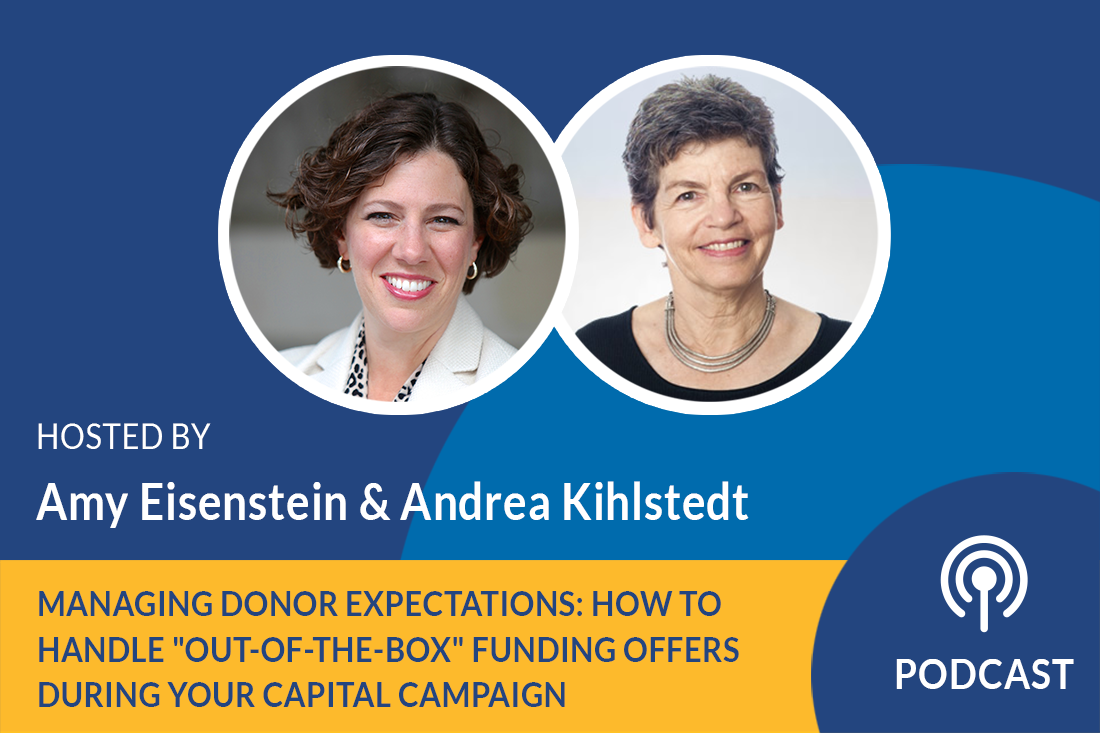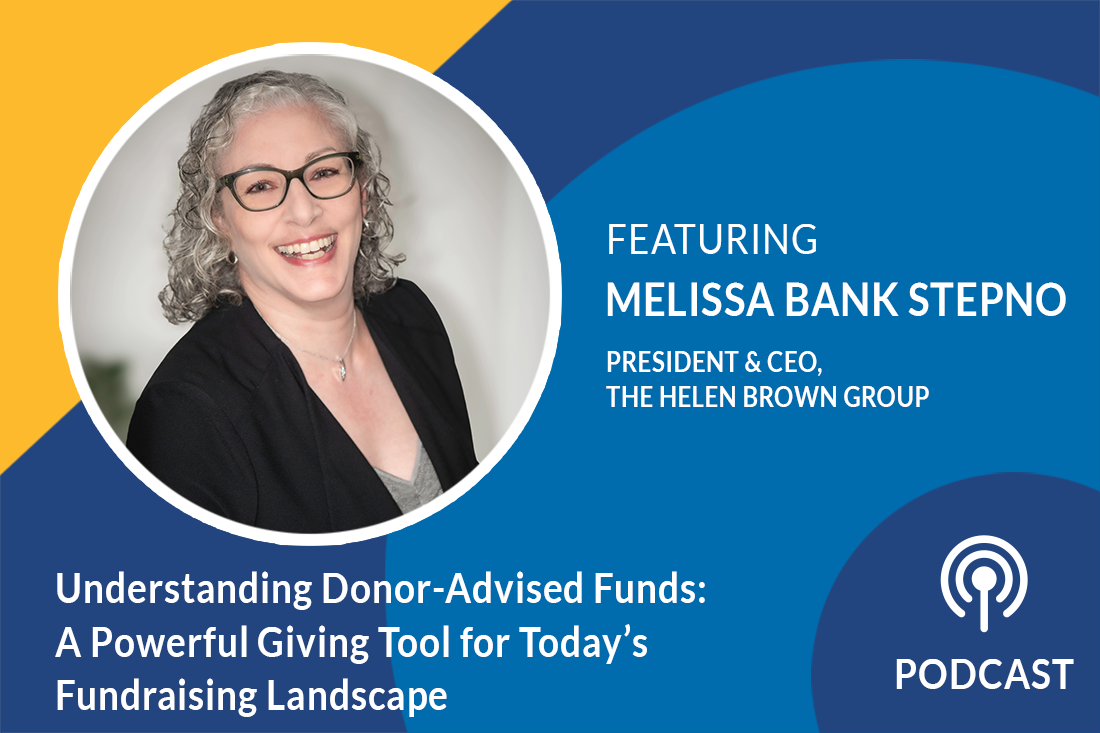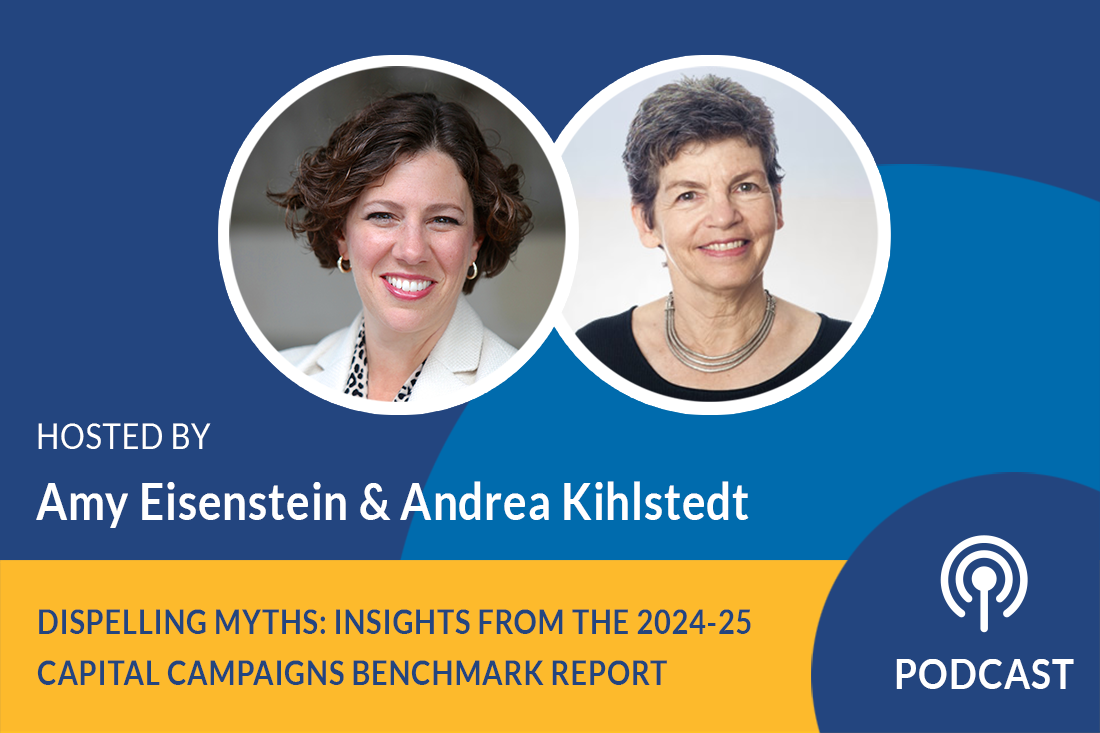Podcast: How to Handle “Out-of-the-Box” Funding Offers During Your Capital Campaign

Season 4, Episode 6
In this episode, hosts Amy Eisenstein and Andrea Kihlstedt dive into the delicate art of managing donor expectations when their funding ideas don’t align with your organization’s mission.
Tune in to learn how to keep your campaign on track, preserve donor relationships, and confidently steer your organization toward success.
Listen Now:
Andrea Kihlstedt:
You might not believe this, but today we’re talking about goats.
Amy Eisenstein:
I’m Amy Eisenstein. I’ve got my partner and co-founder and colleague, Andrea Kihlstedt with us here today and we are super-excited to talk about goats.
All right, Andrea, what are we really talking about?
“Out-of-the-Box” Funding Offers During Your Capital Campaign
Andrea Kihlstedt:
Well, we sort of really are talking about goats. And these days actually people talk about G.O.A.T.S. as meaning someone like these big athletes, these are the greatest of all times. That’s not what we’re talking about.
Amy Eisenstein:
No, we’re not.
Andrea Kihlstedt:
We’re talking about little goats in a pasture, right? Making milk in a pasture.
Let me be clear now — why are we talking about goats in the pasture? Well, because yesterday Amy and I had a conversation with our CEO population, which we do every month where our CEOs come on a call, and one of the CEOs said:
“I have a question about what to do when a wealthy donor comes up to me and says, ‘Listen, I’ll give you a big amount of money if you create a program for starting goat farms in the community.'”
Amy Eisenstein:
In Africa.
Andrea Kihlstedt:
In Africa, yes. Now this organization does serve Africa, but running goat farms in Africa doesn’t compute with what they really are interested in doing. And her question was:
“What do I do when one of my wealthiest donors says, ‘Hey, I’ve got this great idea, which to us looks totally hare-brained?'”
The idea of talking about goats as a stand-in for that, what do you do about a wealthy donor who comes and offers you a significant amount of money for an idea that doesn’t come anywhere close to what your organization’s mission or strategic plans call for?
Amy Eisenstein:
Right. I think that summed it up perfectly. You have this donor, not only are they giving you crazy advice, because I think sometimes that’s the fear is what do I do if my donor suggests something wild? But not only is this donor suggesting something wild, but they’re putting up the funds to back it.
But mission creep or scope creep doesn’t begin to describe this. I mean this has nothing to do with their strategic plan or their mission or their existing programs or services. It is way out there, and obviously the executive director knows she cannot take these funds. The question is of course, what to do.
Help Your Donors Understand Your Plans and Mission
Andrea Kihlstedt:
And that’s the question that we put to all of the CEOs who were on the call and they came up with a bunch of really good suggestions. The gist of most of the suggestions, though we’ll slice and dice this more carefully, but the gist of them is to help the donor understand your mission and your plans more effectively. And help them articulate why what they’re thinking about doing doesn’t really fit into what your mission and your plans are, at least not now.
The idea of saying to the goat donor, “You’re out of your mind,” isn’t obviously a right solution. That’s not a right solution. It’s also not a right solution to say, “Well, that’s a lot of money and I don’t want to offend the donor, so we’ll go ahead and buy a few goats.” That’s not a right solution either, because you’re going to find yourself in the goat business that takes money and effort and energy away from everything else and that you can’t sustain. That’s not an appropriate response.
But the idea of having conversations with that donor and helping them understand what the problems you’re trying to solve are and what the planning process you’ve been through is and what the plans all for. And then getting them to help say:
“Well, what might you do that you would like to do that fits into these plans?”
[That] is where you want to be. Now that sounds simple on the face of it, but donors aren’t always rational or well-behaved.
Amy Eisenstein:
And that’s an understatement.
Three Key Points to Highlight
All right. Let me just chime in for a second, Andrea. I think you made some excellent points that I just want to highlight them.
1. Do Not Kowtow to Donor Ideas that Just Don’t Fit
Number one, you cannot kowtow to the will of your donors crazy ideas. You can’t take this money. The executive director knows she can’t take this money, but I think that often we’re tempted to. I mean they’re offering half a million or a million dollars. It’s really hard for a small organization to turn away that kind of money, but you have to stick to your morals and your strategic plan and you just can’t bend. It really will send you off in the wrong direction. And so, at a minimum you can say, “Listen, I have to run this by my board.”
You can always blame the board. Say, “Listen, it’s an interesting idea.” I think don’t say no right away. Say, “Listen, that’s an interesting idea. We’ve certainly never thought of running a goat farm. I’m not sure it fits in our mission, but let me go talk to the board and I’ll get back to you in two weeks.” And so, one, buy yourself some time to be able to think about how you’re going to respond. Don’t panic in the moment and either say yes or no. You can just stall for a little bit and calmly think about a response. Blame your board. Make it a collective decision so that you are not just saying no and plan out your next conversation. That’s number one.
2. Focus on Your Strategic Priorities
Number two, I think it’s super interesting to say, “Listen, these are our strategic priorities. And they’re not just mine by my own, but over the last two to three years, the board, along with other volunteers and community stakeholders have developed these priorities. And these are our three priorities for the coming five to 10 years. Let’s talk about how your philanthropic priorities might fit one of these three areas. And it probably isn’t a goat farm at this time,” just what you said. I just wanted to emphasize them and clarify a little bit.
Andrea Kihlstedt:
Yeah.
3. Probe to Find Out What Interests Your Donor
Another thing to consider is that every once-in-a-while someone will come up with an idea, will share with you an idea of what they want to do with their money that doesn’t fit your organization, but that might fit another organization that you know of.
For example, what the donor is talking about might fit the zoo, a program you know at the zoo, or you might have a contact for them. You might say, “If you are really interested in this idea about goats, let me put you in touch with my friend so-and-so, where there might be a better fit.” Now —
Amy Eisenstein:
I don’t know about the zoo, but another organization in Africa.
Andrea Kihlstedt:
Another organization, I don’t know. I just used that as a…
Amy Eisenstein:
Of course, of course.
Andrea Kihlstedt:
I’m just trying to make it up. But it’s maybe that you know that if you get on the side of the donor from a situation like this, instead of saying, “Oh my God, this donor’s nuts because what they want to do doesn’t fit with what we want to do.” Instead of thinking that way, you might want to query the donor saying, “What is it about goats that interests you?” Goats standing in, of course, for what the idea is.
“What is it about goats that interests you? Why do you want to do that? And I happen to know somebody that you really should be talking to if you’re seriously interested in this.”
For Most Donors, This is Not a Zero-Sum Universe
Now, what to keep in mind is this, that for many donors, it is not a zero-sum universe. That just because you introduce a donor to someone else, to whom they might give money for a pet project, actually in many cases would increase the likelihood that they would also give money to you when they understand your mission more fully. Don’t be hesitant to get on the donor’s side if you have a sense that the donor has a real passion for something that your organization can’t fulfill.
I think we often think that if a donor is going to give to somebody else, they’re not going to give to us. Whereas a donor who thinks, “Wow, this person really is helping me,” is you simply move that relationship forward in a positive way. I encourage you to do that.
Amy Eisenstein:
I love that, Andrea. And I mean wouldn’t the world be a better place if everybody was doing that and then somebody else is sending a donor to you and you’re sending a donor to somebody else? And I think you’re 100% right. Most donors give to multiple organizations. Instead of thinking of giving your donor away, you’re spreading the wealth, you’re sharing the wealth.
And that donor is more likely to think of you as an ally and be happy to take your calls when you have an idea that works for them and works for you. And then, what goes around comes around. And if you are generous with your contacts and your resources, people are going to be generous with you. I think that’s such a lovely thought.
Andrea Kihlstedt:
Yeah. And it is a lovely thought, and it also happens to work. It’s not just a matter of being a good person.
Amy Eisenstein:
Yes.
Andrea Kihlstedt:
It’s a matter moving your way of working with donors so that you are at least as interested in helping them live out their philanthropic dreams as you are with moving your strategic planning ahead. And if you introduce them to someone who may help them, they may also introduce you to someone that may want to get on your side.
I think the one with the word to describe this is to be generous as you are fundraising, to be generous of spirit, to be generous in all sorts of ways. And so I love the goat story. When our executive director brought it up yesterday it made me chuckle because I could so easily imagine a donor who, from the best of intentions, not knowing very much about these programs that they have in Africa, would think:
“Well, wouldn’t it be great if you have these children taking care of goats and then milking the goats and then bringing the milk home to their parents?”
And just not knowing anything about the realities, the on-the-ground realities.
But the idea is a lovely idea. Not made… And it may have been that simple to say:
“You know what? I really understand that, your desire to do that. Let me tell you where we are going. And let me see if we can help you understand what it’s really like there on the ground in these communities we serve.”
Amy Eisenstein:
Right. Use it as an opportunity to explain in more depth what you are doing and see if there’s a match in terms of the philanthropic priorities of the donors and what your strategic plan is and your strategic priorities.
Final Thoughts
Andrea, you’ve referenced our executive director, CEO call a couple of times, and maybe listeners don’t know what we’re talking about so I just thought I’d share.
Any member of Capital Campaign Pro — any client — is encouraged and invited to send their CEOs to our monthly CEO Roundtable. And it is a group that we convene every single month on Zoom to talk about leadership issues. And with no staff in the room, no board members in the room, CEOs get to ask whatever’s on their mind, share with each other. And it’s always such an amazing learning opportunity and such high level conversations. I think it’s an amazing thing.
Just wanted to share one of the innovative things we’re doing over here at Capital Campaign Pro. And we learn, we love bringing our CEOs together from all over the country and all around the world to talk about the challenges they face. And then their colleagues get to share how they’ve dealt with those challenges. It’s amazing.
Andrea Kihlstedt:
Yeah, I’m always impressed by those calls, Amy, because there is so much wisdom and knowledge and experience in that Zoom room. People do share and have ideas and suggestions. And there are some people who are relatively newcomers to the field and some people with great experience. And when they’re all in Capital Campaigns, they all encounter some very similar issues. It’s just, I always feel like it’s a privilege to be in that room with those smart people.
Amy Eisenstein:
Yeah, it’s definitely a fun thing. I think this was a great topic. If people want to learn more about our programs and services, I would encourage you to visit our website, capitalcampaignpro.com. We’d love to talk to you about how we can help you with the campaign and how we can help think through having these important conversations with your donors. That’s what our advisors do with our clients every single day. We’d love to talk to you about your campaign, and we hope this has been helpful.
Thanks for joining us, and we’ll see you next time.



Leave a Comment